Abstract
Comparative investigations with synthetic N7-phenylguanine were carried out to clarify whether this compound is eliminated via the urine of rats as a benzene-derived nucleic acid adduct. As sensitive methods for detecting trace amounts of the compound, gas chromatography-mass spectroscopy, high performance liquid chromatography, and two immunoassays (enzyme-linked immunosorbent assay and fluoroimmunoassay) with appropriate monoclonal antibodies were used. The results indicate the excretion of several benzene-related guanine adducts slightly different from N7-phenylguanine that may possibly be hydroxylated. These adducts differ also from (O6-, N2- and C8-phenylguanine, respectively.
Full text
PDF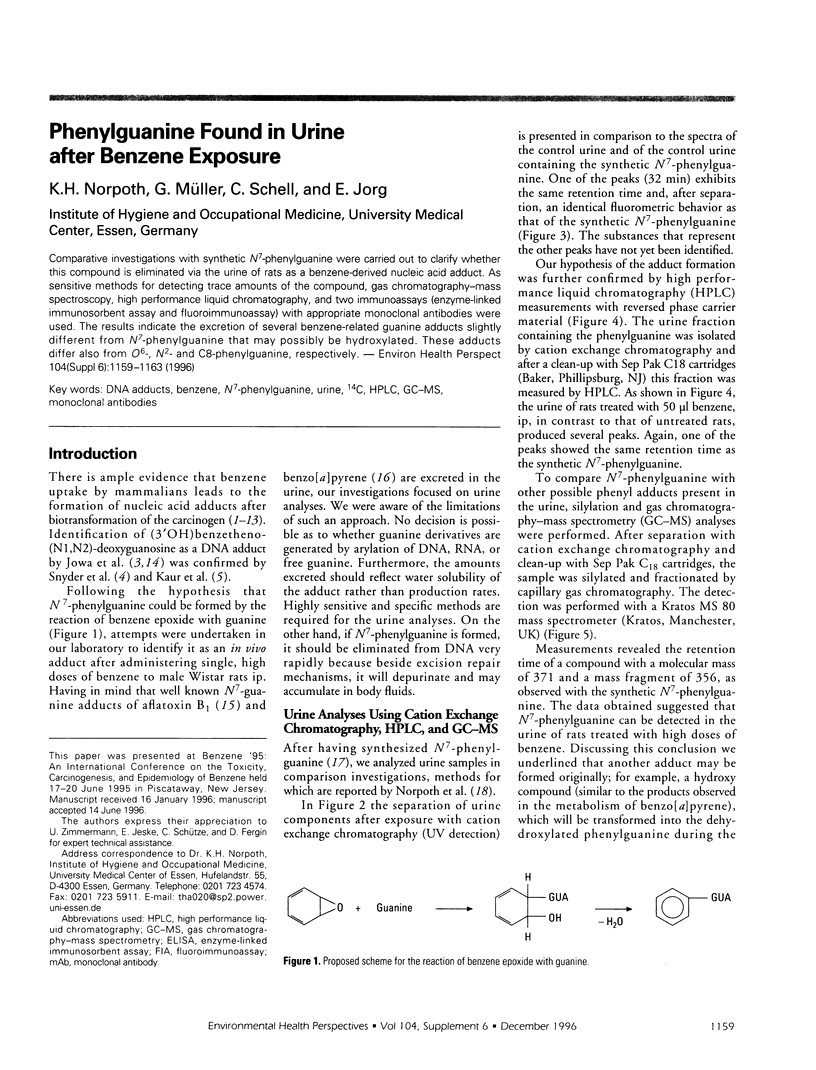
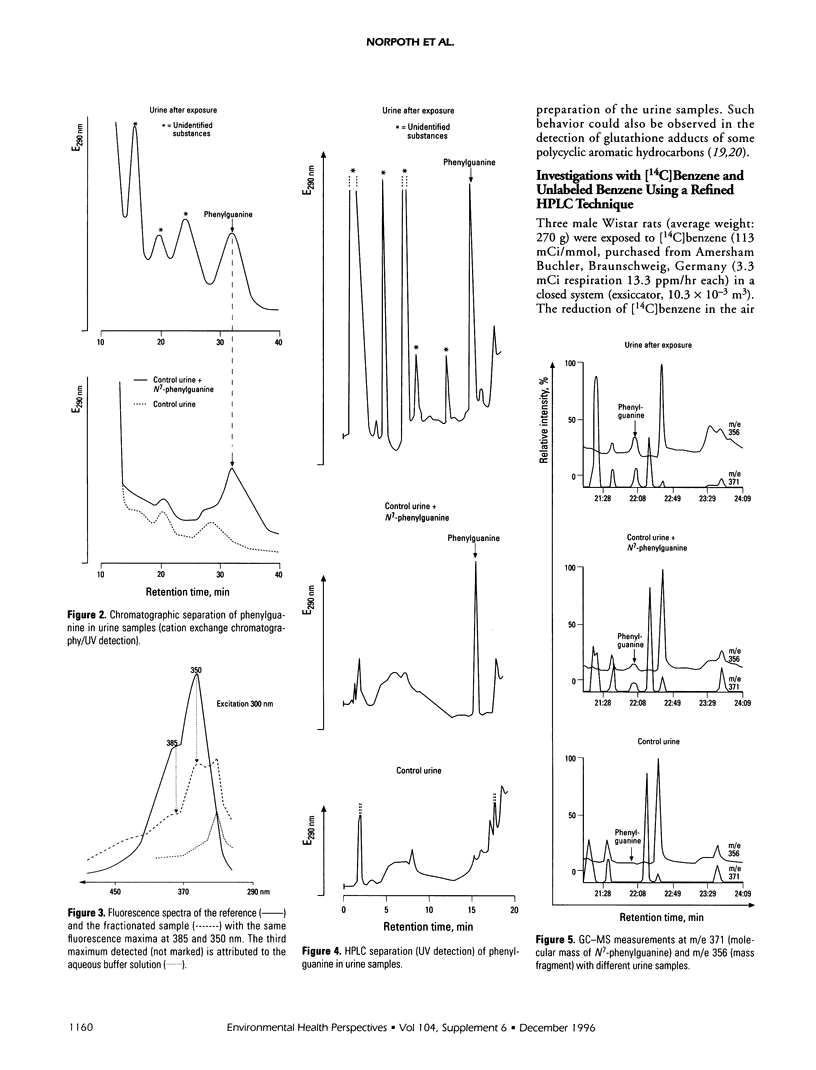
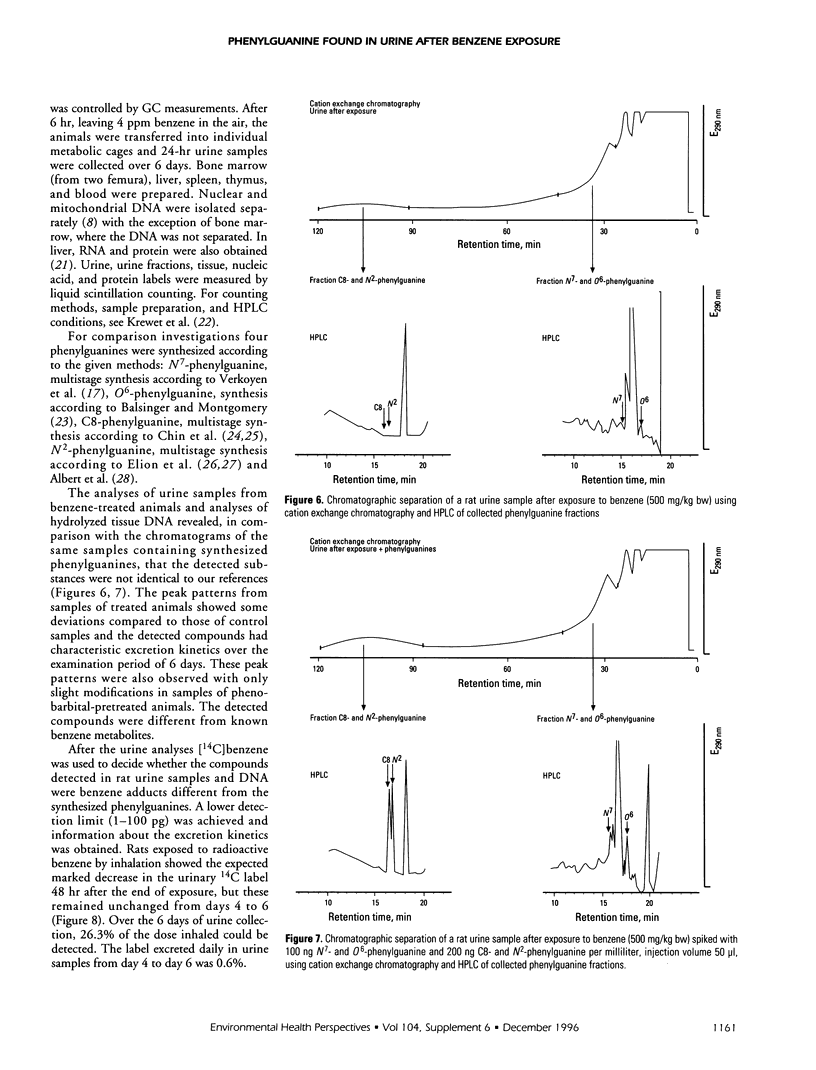
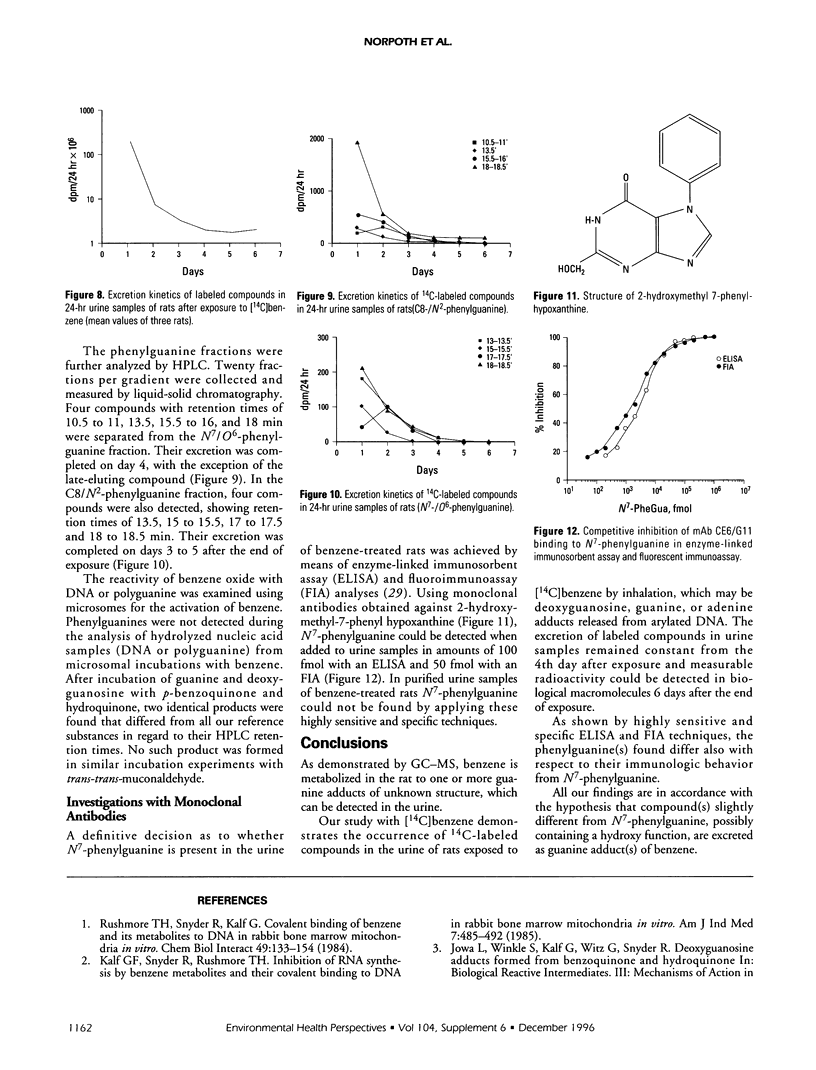
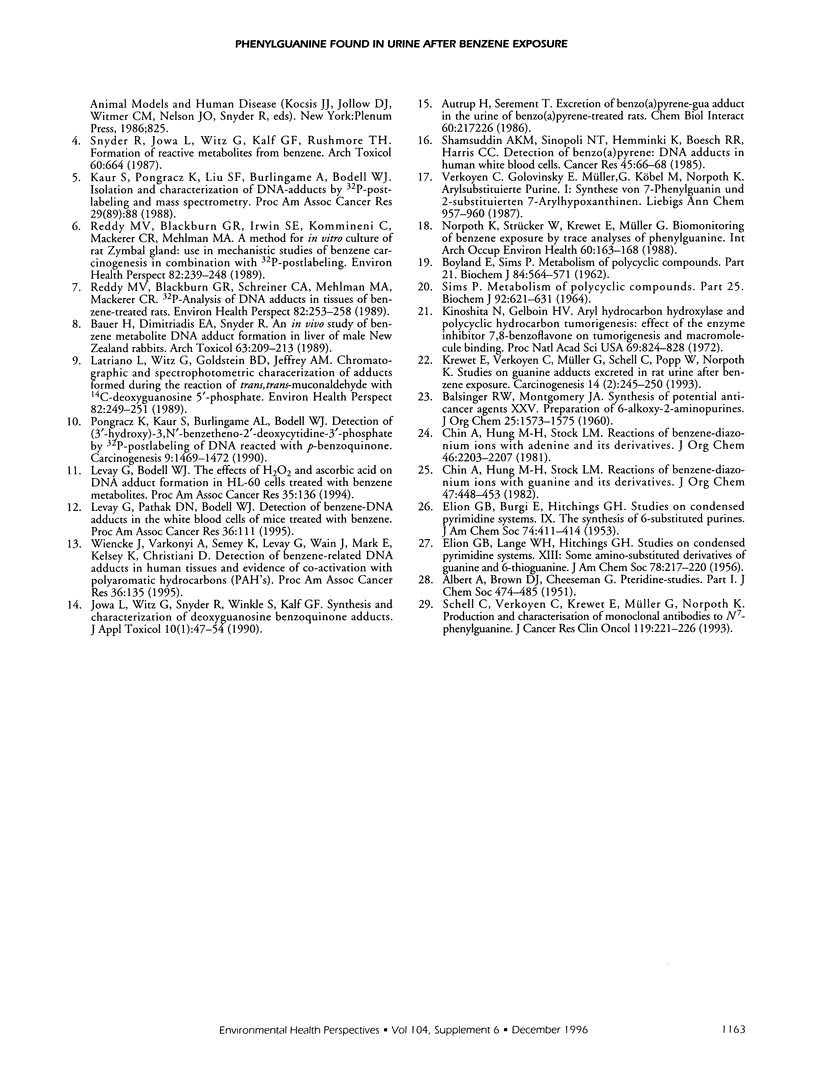
Selected References
These references are in PubMed. This may not be the complete list of references from this article.
- Autrup H., Seremet T. Excretion of benzo[a]pyrene-Gua adduct in the urine of benzo[a]pyrene-treated rats. Chem Biol Interact. 1986 Nov;60(2):217–226. doi: 10.1016/0009-2797(86)90030-x. [DOI] [PubMed] [Google Scholar]
- BOYLAND E., SIMS P. Metabolism of polycyclic compounds. 21. The metabolism of phenanthrene in rabbits and rats: dihydrodihydroxy compounds and related glucosiduronic acids. Biochem J. 1962 Sep;84:571–582. doi: 10.1042/bj0840571. [DOI] [PMC free article] [PubMed] [Google Scholar]
- Bauer H., Dimitriadis E. A., Snyder R. An in vivo study of benzene metabolite DNA adduct formation in liver of male New Zealand rabbits. Arch Toxicol. 1989;63(3):209–213. doi: 10.1007/BF00316370. [DOI] [PubMed] [Google Scholar]
- Jowa L., Witz G., Snyder R., Winkle S., Kalf G. F. Synthesis and characterization of deoxyguanosine-benzoquinone adducts. J Appl Toxicol. 1990 Feb;10(1):47–54. doi: 10.1002/jat.2550100109. [DOI] [PubMed] [Google Scholar]
- Kalf G. F., Snyder R., Rushmore T. H. Inhibition of RNA synthesis by benzene metabolites and their covalent binding to DNA in rabbit bone marrow mitochondria in vitro. Am J Ind Med. 1985;7(5-6):485–492. doi: 10.1002/ajim.4700070512. [DOI] [PubMed] [Google Scholar]
- Kinoshita N., Gelboin H. V. Aryl hydrocarbon hydroxylase and polycyclic hydrocarbon tumorigenesis: effect of the enzyme inhibitor 7,8-benzoflavone on tumorigenesis and macromolecule binding. Proc Natl Acad Sci U S A. 1972 Apr;69(4):824–828. doi: 10.1073/pnas.69.4.824. [DOI] [PMC free article] [PubMed] [Google Scholar]
- Krewet E., Verkoyen C., Müller G., Schell C., Popp W., Norpoth K. Studies on guanine adducts excreted in rat urine after benzene exposure. Carcinogenesis. 1993 Feb;14(2):245–250. doi: 10.1093/carcin/14.2.245. [DOI] [PubMed] [Google Scholar]
- Latriano L., Witz G., Goldstein B. D., Jeffrey A. M. Chromatographic and spectrophotometric characterization of adducts formed during the reaction of trans,trans-muconaldehyde with 14C-deoxyguanosine 5'-phosphate. Environ Health Perspect. 1989 Jul;82:249–251. doi: 10.1289/ehp.8982249. [DOI] [PMC free article] [PubMed] [Google Scholar]
- Norpoth K., Stücker W., Krewet E., Müller G. Biomonitoring of benzene exposure by trace analyses of phenylguanine. Int Arch Occup Environ Health. 1988;60(3):163–168. doi: 10.1007/BF00378692. [DOI] [PubMed] [Google Scholar]
- Pongracz K., Kaur S., Burlingame A. L., Bodell W. J. Detection of (3'-hydroxy)-3,N4-benzetheno-2'-deoxycytidine-3'-phosphate by 32P-postlabeling of DNA reacted with p-benzoquinone. Carcinogenesis. 1990 Sep;11(9):1469–1472. doi: 10.1093/carcin/11.9.1469. [DOI] [PubMed] [Google Scholar]
- Reddy M. V., Blackburn G. R., Irwin S. E., Kommineni C., Mackerer C. R., Mehlman M. A. A method for in vitro culture of rat Zymbal gland: use in mechanistic studies of benzene carcinogenesis in combination with 32P-postlabeling. Environ Health Perspect. 1989 Jul;82:239–247. doi: 10.1289/ehp.8982239. [DOI] [PMC free article] [PubMed] [Google Scholar]
- Reddy M. V., Blackburn G. R., Schreiner C. A., Mehlman M. A., Mackerer C. R. 32P analysis of DNA adducts in tissues of benzene-treated rats. Environ Health Perspect. 1989 Jul;82:253–257. doi: 10.1289/ehp.8982253. [DOI] [PMC free article] [PubMed] [Google Scholar]
- Rushmore T., Snyder R., Kalf G. Covalent binding of benzene and its metabolites to DNA in rabbit bone marrow mitochondria in vitro. Chem Biol Interact. 1984 Apr;49(1-2):133–154. doi: 10.1016/0009-2797(84)90057-7. [DOI] [PubMed] [Google Scholar]
- Schell C., Verkoyen C., Krewet E., Müller G., Norpoth K. Production and characterization of monoclonal antibodies to N7-phenylguanine. J Cancer Res Clin Oncol. 1993;119(4):221–226. doi: 10.1007/BF01624434. [DOI] [PubMed] [Google Scholar]
- Shamsuddin A. K., Sinopoli N. T., Hemminki K., Boesch R. R., Harris C. C. Detection of benzo(a)pyrene:DNA adducts in human white blood cells. Cancer Res. 1985 Jan;45(1):66–68. [PubMed] [Google Scholar]
- Sims P. Metabolism of polycyclic compounds. 25. The metabolism of anthracene and some related compounds in rats. Biochem J. 1964 Sep;92(3):621–631. doi: 10.1042/bj0920621. [DOI] [PMC free article] [PubMed] [Google Scholar]


